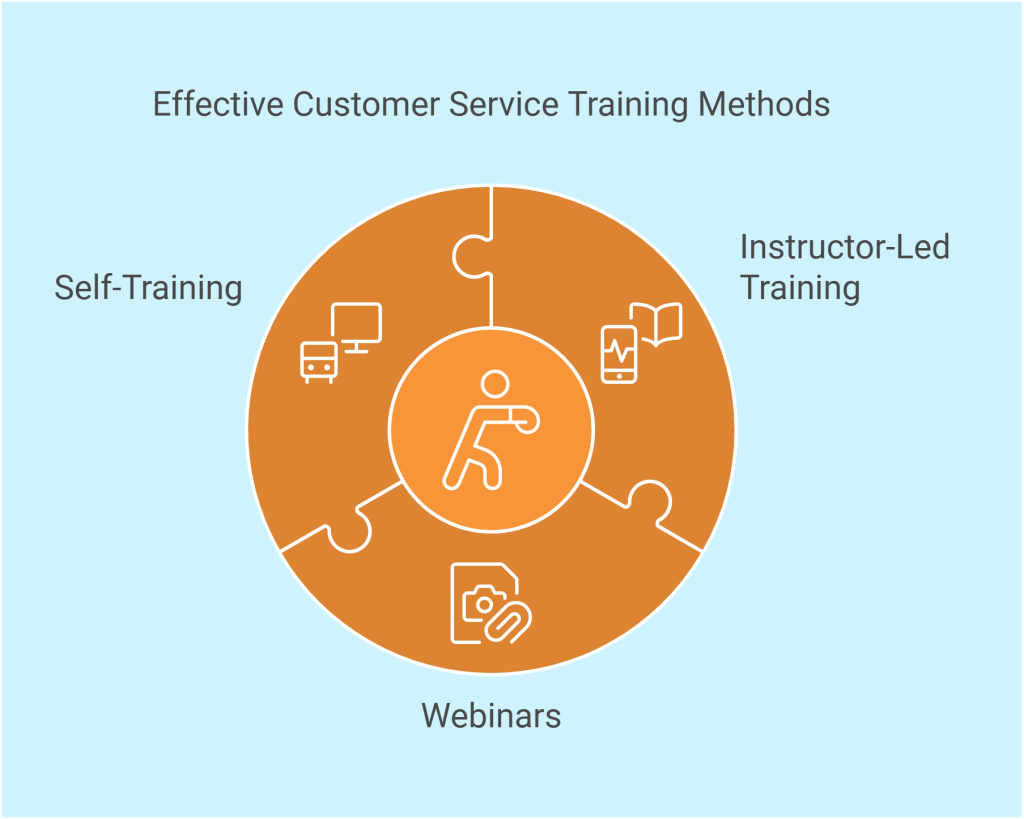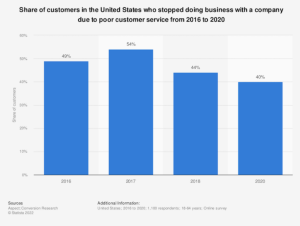Your customer service agents can ruin your brand. Or, they can enhance it!
Your customers’ real-life interactions with your company will give them either a good feeling about doing business with you, or it will make them frustrated.
Your customer service agents are often not only fixing a problem. They’re representing your brand. They’re making you look good – or bad – in the eyes of your customers. So how do you ensure that your customer service agents are providing the best possible experience to your customers? And, how do you know what training is necessary to provide top-notch customer service?
The global customer experience management market is valued at $8.79 billion. And since it’s expected to grow at a compound annual rate of 18.1% between 2022 and 2030, effective customer service training is an absolute necessity.

Using this guide, you will learn how to optimize your customer service training to provide the best customer experience.
What is Customer Service Training?
Customer service training is the process of teaching customer service representatives (CSRs) the skills they need to properly handle customer interactions, complaints, and requests.
The goal of customer service training is to help CSRs better understand customer needs and expectations, as well as how to use company policies and procedures to resolve customer issues.
Customer service training helps you help your customers better and more efficiently.
When Should Customer Service Training Happen?
Customer service training should start as soon as a new hire joins and continue throughout their career. Initial sessions build essential skills, but ongoing training is key to success.
Regular updates keep agents informed on new products, policies, and trends. Proactive training on tools or processes ensures smooth transitions. Continuous learning keeps your team sharp and ready to deliver top-notch service.
Why is Customer Service Training Important?
Simply put, a high level of customer service means more happy customers who are going to recommend your product and service to others.
An employee won’t want to leave a company they believe in, and customers have proven to be very loyal to brands with a higher level of customer service. Not only that but the more comfortable and confident your customer service agents are, the easier it is for them to provide optimal service for your customers
In other words, well-trained employees = satisfied customers and more profits!
Tony Hsieh, best-known as the CEO of Zappos, also co-founded an advertising network that he sold to Microsoft for $265 million. Tony was a huge believer in the importance of customer service:

Source: Hubspot.com
Types of Customer Service Training

It’s important to decide which type of customer service training program will suit your business needs.
Depending on your whether you need longer, or shorter training sessions, here are the three main types of customer service training methods:
1. Instructor-Led Training
This type of training is the most common and usually takes place in a classroom setting. It is in-person, led by a customer service expert who engages with staff in real-time.
Instructor-led training is highly interactive. The instructor will use a variety of methods to teach the material, including lectures, group discussions, role-playing, and simulations. This type of training can also help strengthen the rapport between employees.
2. Webinars
Online customer service training is a great option if you have employees who work remotely or are in different locations. It is typically a more affordable solution and can be done at the employees’ convenience.
All that’s needed is a computer with an internet connection, rather than projector screens, boardrooms, and the need for employees to all be in one location, at the same time. Many companies use learning management systems such as for example LMS by D2L to deliver these webinars, track attendance, and monitor employee progress.
Trainees who are viewing a live webinar can type questions into a chat box or signal to the presenter they’d like to speak.
A major perk of webinars is that they can be recorded and viewed at a later date, in case the employee needs a recap.
The best webinar software also provides viewership statistics. So you’ll know which people watched the entire presentation, you can track attendance, and so on.
You can even create a quiz for attendees to answer after the training.
3. Self-Training
Self-training is a good option for employees who are already experts in customer service and need a refresher. It may also be used by employees who want to set learning objectives, acquire new skills, and gain knowledge through the company’s resources.
This is one of the most cost-effective strategies for teaching customer service and promoting growth in your company.
The most frequent self-learning customer service training options are FAQs, guides, webinars, blogs, video tutorials, etc. Your company could even encourage employees to download Loom videos for offline review. Additionally, you can utilize email marketing software to send employees real-time updates when new training materials become available.
Customer service training is vital. Bad customer service can lead to 40% to 54% of your customers abandoning you.

Source: statista.com
Customer Service Training Steps
With a little guidance, your business can provide excellent customer service. Here are 6 steps to train customer service agents. This will keep your employees, customers, and bottom line happy all at once!
1. Set Clear Expectations
The best way to train customer service agents is to set clear expectations from the get-go. When new employees join, it’s essential that they understand what is expected of them and what behaviors are not acceptable.
Avoid any misunderstandings or conflicts down the road by expressing your expectations clearly, to begin with. It also helps the employee get trained faster, as training is focused on what they need when they need it.
With transparency, your employees can avoid confusion and experience contentment at work. Ultimately, this will lead to happier customer service agents and customers!
2. Train Agents to Be Experts in Your Products/Services
Confidence really does sell! Customers are more likely to purchase a product or service when they can tell the person selling it to them is knowledgeable and confident about what they’re offering.
This is why it’s essential to train your customer service agents to be experts in whatever it is that you’re selling. They need to be able to answer any questions that a customer may have, without hesitation.
A part of this is accepting feedback and continually finding ways to improve your product/service, together as a team.
3. Teach Phone Call Communication Skills
Phone call communication skills are highly underrated in training customer service agents. In this day and age, it’s easy to lose the personal touch that comes with a phone call.
Excellent phone call communication skills are an important aspect of customer service. After all, not every customer is going to want to communicate via email or chat box. Some are more comfortable picking up the phone and speaking to someone directly.
Your agents should know how to greet the customer, sound interested in what they have to say, and be able to build trust quickly. In addition, they should know when to end the conversation politely.
These are all essential skills that can be used on or off the phone (such as during live chat assistance) and will help create a positive customer experience!
4. Utilize a Mentorship Program
When you pair up new employees with more seasoned ones, they can learn from their mistakes, as well as their successes. They can also guide the newer agents and give them the knowledge they need to excel.
Ultimately, the more support that employees feel they have, the more likely they are to stick around and be productive, contributing members of the team.
5. Provide Customer Service Training Materials
Access to great resources can make all the difference. For example, ensuring employees have the right tools and study materials, such as Microsoft AZ-500 Practice Test Dumps, can empower them with the knowledge to excel in their roles.
This includes product information, company policies, and even industry news. The more knowledgeable your agents, the better equipped they will be to handle any situation that comes their way. And, the more likely it is that they will provide excellent customer service!
For instance, for testing things like spelling, grammar, and typing skills, give your agents this fun live agent test tool to boost their customer service abilities.
To keep your customer service agents organized, you can provide them with outstanding ticket management software.
6. Conduct Ongoing Customer Service Training
It is important to understand that a part of how to train customer service agents correctly is to never stop. These are the employees interacting with your customers on a daily basis.
Things change, and the only way to survive (and thrive) through these changes, is to adapt and change with them.
This is why it’s essential to conduct ongoing training with your customer service agents. This way, they are always up-to-date on the latest information, news, and updates within the company.
So, are you ready to train your customer service agents properly? If so, your customers and employees will thank you for it.




